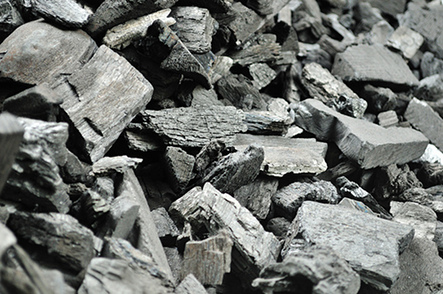The following is excerpted from The Biochar Debate: Charcoal’s Potential to Reverse Climate Change and Build Soil Fertility, available from Chelsea Green.
Charcoal and biochar
Charcoal is one of the oldest industrial technologies, perhaps the oldest. In the last decade there has been a growing wave of excitement engulfing it. Why?
Because some scientists are saying that we might be saved from the worst effects of global warming if we bury large quantities of it. Not only that: we can restore degraded land and get better harvests by mixing fine-grained charcoal — biochar — with soil. Others say that charcoal’s use could be just one of several technologies to mitigate climate change. Yet some maintain that it is an extremely dangerous technology. The jury is out on which is closest to reality. This Briefing aims to provide an overall view of the subject and describes the best way to encourage the appropriate use of biochar.
The theory is simple. Plants, through photosynthesis, capture carbon dioxide-the main greenhouse gas-from the air as they grow. The carbon of CO2 provides their structure and the oxygen is released for animals to breathe. If the plants are left to rot, the C and O combine again in a relatively short time to release carbon dioxide back into the air. However, if the plants are heated in the absence of oxygen — called pyrolysis — charcoal is formed. Charcoal is largely carbon. As anyone who has organized a barbecue knows, charcoal can be burned, in which case the carbon goes back up into the atmosphere. But if it is buried, the two elements take a long time to recombine as carbon dioxide. This means that some of the most abundant greenhouse gas can be taken out of the atmosphere and locked into the ground for a long time. Deep burial-rather like putting coal back where it belongs-is one way. But there is another option.
Additional excitement came with the discovery of deep dark areas of “terra preta do indio” — Indian black earth — in the Amazon rainforest where the soil generally is thin, red, acidic and infertile. The patches of terra preta are alkaline with a high carbon content, and contain potshards indicating that it was not natural: a pre-Columbian civilization had created it. It is extracted and widely used by garden contractors because it is so fertile. It has remained fertile and retained its carbon content through the centuries.
Terra preta is black because it contains large amounts of charcoal. Infertile land had been converted to fertile land that supported a thriving civilization through the wise use of the trees that had been felled. Could charcoal, therefore, not only be a vehicle for reducing global warming but also a means to increase the fertility of degraded land, and help feed the world?
Charcoal used for this purpose is referred to as biochar. Biochar is pulverised charcoal made from any organic material (not just wood) and, when mixed with soil, it enhances its fertility. It locks carbon into the soil and increases the yield of crops. To many, this appears the closest thing to a miracle.
The process of converting plant material to charcoal gives off heat together with gases and oils. Certain plants and certain processes produce a high proportion of charcoal, whereas others produce more gases and oils. This is where the problems start. These chemicals could become the main commercial attraction of biochar. As has been found with biofuel, growing crops to fuel cars can be more profitable than growing food to feed people. If left to the market, producers of biochar might buy up productive land, plant monocultures, and develop their equipment primarily to produce fuel and industrial chemicals.
Then there is the suggestion that the burial of charcoal should earn carbon credits. As above, the financial motive could lead to “growing carbon credits” in preference to growing food. And if widely adopted, as hoped, the carbon market would be flooded with credits; industry would buy them at fire-sale prices and carry on with business as usual to the detriment of the climate. A strong financial incentive to use biochar is desirable, but carbon credits may not be the best approach.
There are two prime objectives. It is essential to find ways to sequester greenhouse gases if we are to avoid the worst effects of global warming. It is essential also to enable farmers throughout the world to use biochar if it can bring degraded land back to fertility and increase yields. The process cannot be left to “the market,” which has been described as an out-of-control demolition ball swinging from a high crane.
In the final chapter I outline twin policies for reducing greenhouse gases in the atmosphere. The first policy would ensure a reduction in the use of fossil fuels. The second concerns our use of land. The requirements for the two are so different that separate regulations are necessary. The first is called cap-and-dividend (in the US). The second is the Irish proposal for a Carbon Maintenance Fee (CMF), which would provide a powerful incentive for every country, rich and poor, to enable its farmers, businesses and individuals to maintain land-based carbon.
A visit to India
I had been caught up in the excitement surrounding biochar before visiting India in January 2008. While there I asked everyone I met about the production and use of charcoal. My obsession was embarrassing for my wife Marion, but paid off when it led to meeting Dr. Ravikumar of the Centre for Appropriate Rural Technology (CART) in Mysore. He talked about a “charcoal revolution” that would bring employment to the rural poor. He had been working on stoves to produce charcoal in the absence of oxygen for about eight years at CART. But CART was closing, so he was looking for an organization to promote the development of his ideas. I suggested he contact our friends Amali and Cletus Babu, who had started the non-governmental organization SCAD, Social Change and Development, in the southern tip of India 25 years earlier. Their objective is also to bring knowledge and employment to communities in the 450 villages where SCAD works.
Later, David Friese-Greene, while visiting SCAD, was taken to meet some banana growers who had been adding charcoal dust to their crops during the last four years. They had tried this quite by chance, having come across a supply of almost free charcoal made from rice-husks as a by-product of some other process. They told David that digging it in with the banana plants cut the amount of irrigation water needed in half and doubled the yield of their crop. Maybe there was a bit of exaggeration here — I don’t know. They added that the bananas taste better. In Britain we only receive one kind of banana, referred to by our Indian friends as tasting like expanded polystyrene, but there is a great variety in south India and the different tastes are appreciated and affect sales. Neighbouring farmers have been impressed with the results and are adopting their practice.
The fact that burying charcoal extracts carbon dioxide from the atmosphere is of little significance to SCAD’s farmers. They are only interested in increasing the yield of their crops. If this can be clearly demonstrated to, or by, farmers, and if the equipment for producing the charcoal were affordable and available, the practice would spread naturally.
But everyone in India is aware of carbon credits. They are like a magic wand, a source of income and development whether or not they are truly effective in reducing carbon emissions, or whether they simply allow Western industry to carry on emitting as usual. So we discussed the subject.
If the farmers were to earn carbon credits, surely this would be an added benefit for them? Possibly; but possibly not. There is no way in which these farmers could take part in transnational economic mechanisms. As the value of credits rose to exceed the value of food crops, the smallholders would be displaced by agribusiness seeking to accumulate large areas and plant monoculture crops primarily for the purpose of attracting credits. Only agribusiness could handle the complicated global trade. The process would require an army of monitors, but this would be an open invitation for corruption. Western entrepreneurs looking to extract profit would descend like hawks. And, of course, setting up this novel kind of infrastructure would take years. In a small way in this corner of India I had become aware of the arguments taking place more widely between advocates and opponents of biochar.
The players
The uncertainties associated with biochar — proof of its permanence, its effect on forests and crops, the million different ways in which it might be used, certification, the money trail — are more complex than negotiators have ever previously encountered. Coming to a global agreement on carbon credits for charcoal would take years. And if it were successful, the carbon market would be flooded with credits and collapse. Industry would then have little restraint on its emissions. How many more years of failure before the rich are prevented from buying indulgences that allow them to carry on making yet more money while destroying the climate? And how much time do we have? The legacy of national leaders will not be determined by their handling of war, terrorism, or the economy but by their failure to take immediate action over the threat of global warming. They could initiate measures to encourage biochar within a month, given the will.
The aforementioned governments and global negotiators are one group of players. In addition there are many groups involved in promoting the use of charcoal for sequestration that are primarily concerned with understanding the science, demonstrating the benefits, and promoting good practice. The International Biochar Initiative (IBI) is a leading body promoting scientific and practical understanding.
The most thorough scientific study so far is Biochar for Environmental Management, edited by Johannes Lehmann and Stephen Joseph, and I refer to it frequently. Chapters are written by scientists for scientists — each concentrating on a single aspect — demonstrating the ecological complexity of biological systems and, incidentally, vividly showing how difficult it would be to define, for commercial purposes, its effectiveness in sequestering carbon dioxide. The book has few direct hints for farmers and is rather impenetrable for the general reader.
There is a need for an intermediate organisation to translate theory into advice, in the way that the USDA-funded National Sustainable Agriculture Information Service advises organic farmers. Practitioners using trial-and-error methods throw up complex, messy, and difficult questions that cannot be resolved simply by reference to the science.
Then there are commentators who talk of economics and regulation. However, scientists, practitioners, and commentators all agree that a great deal of research and trial will be necessary for a full understanding and application of the process. Scientific uncertainty over the application of biochar, however, is no reason to rubbish the whole subject. By doing this the biochar skeptics lose credibility for their reasoned campaign against the market-based approach. Remember that uncertainty over detail was used to great effect by climate skeptics who wished to rubbish the science of climate change.
Biofuelwatch is an organisation that has highlighted the dangers of biofuels and argues that many of the same dangers apply to the development of biochar. Some industrialists see charcoal just as a by-product of a process that is primarily focused on producing biofuel. Companies developing biofuel aim to replace fossil fuels with “clean” energy from plants, though the claim to be clean has proved faulty in many cases. It is also generally accepted that the rise in food prices above what many of the poor can afford is due largely to biofuels displacing grain crops. Biofuelwatch examines what would happen if the production and burial of charcoal were to earn carbon credits under the Kyoto Protocol or its successor. As the availability of fossil fuels diminishes, the value of these credits could become so huge that commercial interests would initiate planetary geo-engineering projects-Shell and J. P. Morgan are already in on the act — and farming could give way to industrial monocultures that would have unknown but potentially disastrous consequences for the climate, for people, and for biodiversity.
Then there is James Lovelock. In a recent interview in New Scientist replying to the question “Are we doomed?” he said, “There is one way we could save ourselves and that is through the massive burial of charcoal. It would mean farmers turning all their agricultural waste — which contains carbon that the plants have spent the summer sequestering — into non-biodegradable charcoal, and burying it in the soil. Then you can start shifting really hefty quantities of carbon out of the system and pull the carbon dioxide down quite fast. . . . This scheme would need no subsidy: the farmer would make a profit.” Note that his focus is on farming, not on economic mechanisms.
Chris Goodall includes biochar in his excellent book Ten Technologies to Save the Planet. This analyses each of the technologies from a commercial perspective. Only two of the technologies would extract carbon dioxide; the others would just reduce emissions. There are many other books and magazine articles that touch on the subject. In his book Sustainable Energy-Without the Hot Air Professor David MacKay analyses the potential sustainable fuels for Britain. He describes his approach as “numbers not adjectives”-i.e. setting aside preconceptions, economics, politics, and even ethics. He analyzes the potential and limitations of each permanent energy source, with solar photovoltaics emerging as having the greatest potential. It is interesting that 70 percent of renewable energy will reach the end user as electricity. This is important for determining the type of equipment that should be researched and developed. One of the biggest savings as compared with present energy use will be in doing away with the need to convert fossil energy into electricity.
In all of this I have been influenced by the philosophy of Fritz Schumacher, best known for his classic work, Small is Beautiful. If his recommendations had been followed, we would not be in the mess we are in today. I have found much in his work that is directly relevant to the use of biochar, so I have tried to look at the issues through his eyes.
As you can see from the above, this Briefing is not just about the stuff we burn in barbecues. A very old technology — the production of charcoal — in the hands of farmers throughout the world could become a major player in the struggle to avoid the worst effects of global warming. Given such potential, it must be considered in relation to the global economy, to commercial pressures, to international negotiations, and not least in relation to agricultural practice.
Charcoal image by Gregory Moine, courtesy of Creative Commons license.









